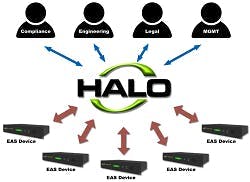Monroe Electronics HALO
Monroe Electronics has created HALO to answer the need for a highly specialized management system capable of overseeing all EAS encoder/decoders.
It provides an enterprise-wide command of all the EAS devices in a connected organization - the most effective way to combine operational and compliance focus under a unified configuration control, EAS log reporting and error/alarm monitoring program, Monroe says. HALO is designed to provide a collective point where multiple users can monitor the overall EAS equipment "health," manage and compare configuration settings; manage software updates; receive timely notifications regarding equipment status changes, configuration changes, and alerts; and then generate accurate FCC compliance and inventory reports. All of these elements streamline the complex processes performed throughout the organization and, more than anything, decrease the time spent on EAS-related matters while simultaneously reducing errors, increasing efficiencies and proactively addressing any potential compliance or subscriber issues, says Monroe.
